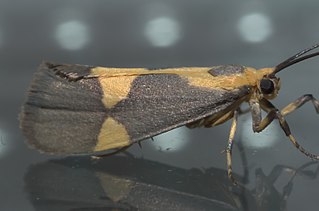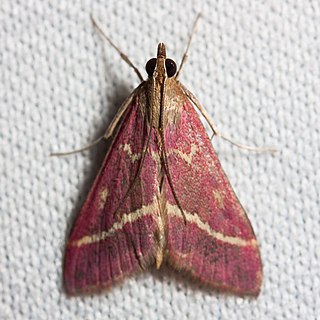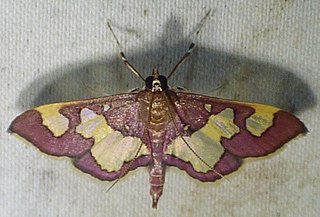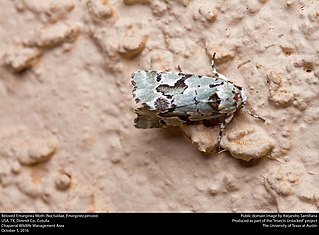
Apantesis is a genus of tiger moths in the family Erebidae first described by Francis Walker in 1855. They are found in North and Central America.

Desmia is a genus of moths of the family Crambidae. The genus was erected by John O. Westwood in 1832.

Apantesis anna, the Anna tiger moth, is a moth of the family Erebidae. It was described by Augustus Radcliffe Grote in 1863. It is found from Maine to the mountains of North Carolina, west to Nebraska and Arkansas.
Halysidota cinctipes, the gartered halysidota or Florida tussock moth, is a species of moth in the family Erebidae. It was described by Augustus Radcliffe Grote in 1865. It is found on Cuba, Haiti, the Bahamas and in the US states of Florida, Texas, Arizona and California. The range possibly extends through Mexico, Guatemala, Costa Rica and Panama to Venezuela, Brazil and Peru.

Cisthene unifascia is a moth of the family Erebidae. It was described by Augustus Radcliffe Grote and Coleman Townsend Robinson in 1868. It is found in the southern United States and Mexico.
Pseudohemihyalea labecula, the freckled glassy-wing, is a moth in the family Erebidae. It was described by Augustus Radcliffe Grote in 1881. It is found in the United States in southern Nevada, Utah, from Colorado to Arizona, New Mexico and western Texas.
Pygarctia matudai is a species of moth in the family Erebidae. It was described by Carlos Rommel Beutelspacher in 1978. It is found in Mexico.

Pygarctia roseicapitis, the red-headed pygarctia moth, is a moth in the family Erebidae. It was described by Berthold Neumoegen and Harrison Gray Dyar Jr. in 1893. It is found in Mexico and in the United States from southern Arizona to Texas.
Petrophila avernalis is a moth in the family Crambidae. It was described by Augustus Radcliffe Grote in 1878. It is found in North America, where it has been recorded from Arizona, Colorado, New Mexico, South Dakota and Wyoming.
Evergestis obliqualis is a moth in the family Crambidae. It was described by Augustus Radcliffe Grote in 1883. It is found in North America, where it has been recorded from Arizona, California, Colorado, New Mexico, Texas and Utah.

Pyrausta volupialis, the volupial pyrausta moth, is a moth in the family Crambidae. It was described by Augustus Radcliffe Grote in 1877. It is found in North America, where it has been recorded from Oklahoma, Utah, Texas, Colorado, New Mexico, Arizona and California to Chiapas, Mexico.

Colomychus talis, the distinguished colymychus moth, is a moth in the family Crambidae. It was described by Augustus Radcliffe Grote in 1878. It is found in Mexico and the south-eastern United States, where it has been recorded from Alabama, Arkansas, Florida, Georgia, Maryland, North Carolina, Oklahoma, South Carolina and Virginia.
Desmia deploralis, the deploring desmia moth, is a moth in the family Crambidae. It was described by George Hampson in 1912. It is found in Paraguay, Cuba, Jamaica and Florida.
Desmia ploralis, the mournful desmia moth, is a moth in the family Crambidae. It was described by Achille Guenée in 1854. It is found in French Guiana, Suriname, Brazil, Guatemala, Costa Rica, Mexico, the Caribbean and Florida.
Eulepte anticostalis is a moth in the family Crambidae. It was described by Augustus Radcliffe Grote in 1871. It is found in North America, where it has been recorded from Florida to North Carolina and west to Texas. It is also found on Puerto Rico.
Eurrhyparodes lygdamis is a moth in the family Crambidae. It was described by Herbert Druce in 1902. It is found in the United States, where it has been recorded from Florida to Texas and from Mexico to Brazil.
Loxomorpha flavidissimalis is a moth in the family Crambidae. It was described by Augustus Radcliffe Grote in 1877. It is found in the United States, where it has been recorded from Texas, Florida, North Carolina and West Virginia. It is also found in Mexico and Puerto Rico. It has also been recorded from Australia.
Lygropia plumbicostalis is a moth in the family Crambidae. It was described by Augustus Radcliffe Grote in 1871. It is found in North America, where it has been recorded from Arizona, Florida and Texas.
Noctuini is a tribe of owlet moths in the family Noctuidae. There are at least 520 described species in Noctuini.

Psaphidini is a tribe of owlet moths in the family Noctuidae. There are at least 40 genera and at least 90 described species in Psaphidini.








